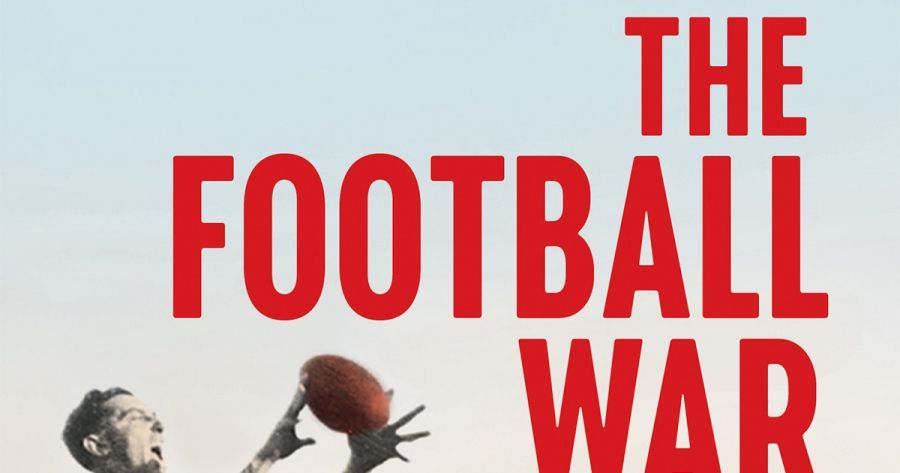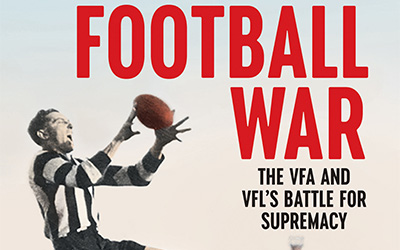
- Free Article: No
- Contents Category: Sport
- Review Article: Yes
- Article Title: Up there Todd!
- Article Subtitle: Football’s internecine history
- Online Only: Yes
- Custom Highlight Text:
Imagine the uproar if Nick Daicos left Collingwood tomorrow, seduced by a huge financial offer from a rival Australian football competition. Imagine if the reigning Brownlow Medallist, Patrick Cripps, followed suit, then Christian Petracca and Charlie Curnow and more. Chaos would ensue.
- Featured Image (400px * 250px):

- Alt Tag (Featured Image): Michael Roberts reviews ‘The Football War: The VFA and VFL’s battle for supremacy’ by Xavier Fowler
- Book 1 Title: The Football War
- Book 1 Subtitle: The VFA and VFL’s battle for supremacy
- Book 1 Biblio: Melbourne University Press, $39.99 pb, 306 pp
- Book 1 Cover Small (400 x 600):

- Book 1 Cover (800 x 1200):

- Book 1 Readings Link: https://www.readings.com.au/product/9780522880076/the-football-war--xavier-fowler--2024--9780522880076#rac:jokjjzr6ly9m
How that happened, why it happened, and how it all played out is the subject of historian Xavier Fowler’s new book, The Football War: The VFA and VFL’s battle for supremacy. It is, even the author concedes, a ‘narrow, almost quirky’ topic for a book. But it is fascinating nonetheless. Partly this is because of the history between the two bodies. The VFA, formed in 1877, was the first serious organised football competition in Victoria. Twenty years later, the eight biggest and most powerful VFA clubs – including Collingwood, Carlton, Essendon, Melbourne, and Geelong – seceded and formed a new competition known as the Victorian Football League. The breakaway league immediately usurped the VFA as the premier competition in the state.
There was always a simmering bitterness between the two bodies, most of it emanating from the VFA. There was also a clear and well-established order: the VFL was the big dog, with the VFA a decidedly distant second – a place for players either not good enough, or too old, for the League.
By the late 1930s, however, the VFA decided to launch an assault, and that’s where The Football War comes in. Fowler details how the relationship between the two bodies soured, leading the Association to introduce its own rules, such as the throw-pass, a throw with both hands executed below shoulder height. This, and other rule changes, made the Association version of the game faster and more open.
The VFA also spread its focus wider, building teams in the growing outer suburbs of Melbourne. Most conspicuously, it attracted well-heeled businessmen who started offering huge sums of money to aggressively poach some of the biggest names from the VFL, including future Australian Football Hall of Famers Bob Pratt, Ron Todd, Laurie Nash, and Des Fothergill. They briefly had Jack Dyer, too, before he changed his mind.
All this has been covered before in other football histories, but not in such depth. Fowler has done his research, and it shows. Some of the detail he has uncovered is eye-opening, to say the least. The brutal politicking (especially from the VFL and its mates), the internecine wranglings, the skullduggery, and the undermining of the VFA’s campaign are all laid bare here. So are the missteps from both camps that shaped how the fight unfolded.
One of the great attractions of the book is Fowler’s decision to tell significant parts of the story through the experiences of those most deeply affected, especially Pratt, Todd, Nash, and Dyer, as well as VFA legend Tommy Lahiff. This approach pays dividends when it comes to the brilliant Todd, who may well have become the game’s greatest-ever spearhead had he not succumbed to the riches offered by Williamstown.
The Football War delves deeply into Todd’s involvement, revisiting the frequent changes of heart that hint at the angst he must have suffered. Fowler even goes so far as to count up all the speculative print stories on the issue that appeared in one three-week period (ninety-five!), underlining just what a media storm it had become. When it was all over, Todd announced that he would have to take himself away to the Murray for two weeks to recover.
It is fascinating to see the emergence of issues that are still with us today, such as the concerns over increasing player power and the amounts of money on offer. Amusingly, there was also uproar over the standard of umpiring and players not being given enough time to dispose of the ball when tackled – an exact mirror of one of the hot topics from the AFL’s 2024 season.
By the end of 1939, the VFA was, against all odds, making headway. Crowds were growing, fans drawn by the influx of big names and the high-scoring, free-flowing football that was possible under the throw-pass rules. VFL crowds, on the other hand, were softening, fans turning away from the more congested, violent version of the game. When Todd crossed over for the 1940 season, along with a number of others, serious inroads looked possible.
Not long after, a real war intervened. The VFA went into recess for three years during World War II, everyone’s focus shifted elsewhere, and the challenge lost momentum. In the end, the VFA gave up on the throw-pass and by the late 1940s had rejoined the mainstream. It is intriguing to see how many of the other rule changes they introduced have remained in the game in one form or another.
This chapter in football history has never received the attention it warrants. Xavier Fowler’s book corrects that imbalance, providing us with a far better understanding of what happened and how it still affects the game today. It also gives the now-defunct VFA a little more of the credit it deserves for the role it played in the story of Australian football.


Comments powered by CComment